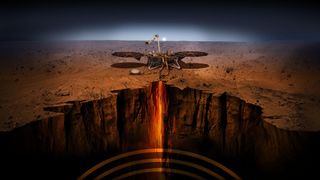NASA's InSight Mars lander hunkering down in Red Planet dust storm
The agency said it hopes to take InSight out of safe mode next week.

One of NASA's Mars robots is in safe mode to save power while a dust storm blocks its solar panels from charging.
The InSight lander, which is designed to study the interior of Mars, is stable in its safe mode, which the spacecraft initiated on Jan. 7, the agency said in a mission status update published Tuesday (Jan. 11). The lander safely communicated with ground controllers on Monday (Jan. 10) despite the temporary measure to ride out a regional dust storm.
"Its power was holding steady and, while low, was unlikely to be draining the lander’s batteries," NASA officials wrote. For now, this steady power likely means that InSight will not face the same demise as the long-running Opportunity Mars rover, which fell silent in 2018 during a series of global dust storms that ultimately emptied the rover's batteries.
Mars InSight in photos: NASA's mission to probe core of the Red Planet
InSight, which landed on the Red Planet in 2018, was already working at reduced power due to normal buildup of dust on its two solar panels. Engineers somewhat reduced the dust on one panel in 2021 by using a scoop on the lander's robotic arm to drizzle dust into the wind, but "these activities become increasingly difficult as available energy decreases," NASA officials wrote in the new update.
Indeed, reduced power is one of the greatest threats to the mission and could end the activities of InSight sometime in 2022, the agency said last year. The threat comes from a combination of the planet reaching its greatest distance from the sun last year and seasonal cycles of dust activity in the atmosphere, mission personnel said at the time.
Predictions are, however, that InSight should have enough power for the time being to survive this particular dust event, although the agency said they are hoping to control the lander more in the coming days to conserve its energy.
Get the Space.com Newsletter
Breaking space news, the latest updates on rocket launches, skywatching events and more!

"InSight's engineers are hopeful they will be able to command the lander to exit safe mode next week," NASA said. "This will allow more flexibility in operating the lander, as communication, which requires a relatively large amount of energy, is limited in safe mode to conserve battery charge."
Opportunity and its twin rover, Spirit, did benefit from periodic dust-clearing events due to windy conditions on Mars. But such an event hasn't happened yet to InSight, even though the lander has detected several whirlwinds going by, according to NASA.
Follow Elizabeth Howell on Twitter @howellspace. Follow us on Twitter @Spacedotcom and on Facebook.
Join our Space Forums to keep talking space on the latest missions, night sky and more! And if you have a news tip, correction or comment, let us know at: community@space.com.

Elizabeth Howell (she/her), Ph.D., is a staff writer in the spaceflight channel since 2022 covering diversity, education and gaming as well. She was contributing writer for Space.com for 10 years before joining full-time. Elizabeth's reporting includes multiple exclusives with the White House and Office of the Vice-President of the United States, an exclusive conversation with aspiring space tourist (and NSYNC bassist) Lance Bass, speaking several times with the International Space Station, witnessing five human spaceflight launches on two continents, flying parabolic, working inside a spacesuit, and participating in a simulated Mars mission. Her latest book, "Why Am I Taller?", is co-written with astronaut Dave Williams. Elizabeth holds a Ph.D. and M.Sc. in Space Studies from the University of North Dakota, a Bachelor of Journalism from Canada's Carleton University and a Bachelor of History from Canada's Athabasca University. Elizabeth is also a post-secondary instructor in communications and science at several institutions since 2015; her experience includes developing and teaching an astronomy course at Canada's Algonquin College (with Indigenous content as well) to more than 1,000 students since 2020. Elizabeth first got interested in space after watching the movie Apollo 13 in 1996, and still wants to be an astronaut someday. Mastodon: https://qoto.org/@howellspace
